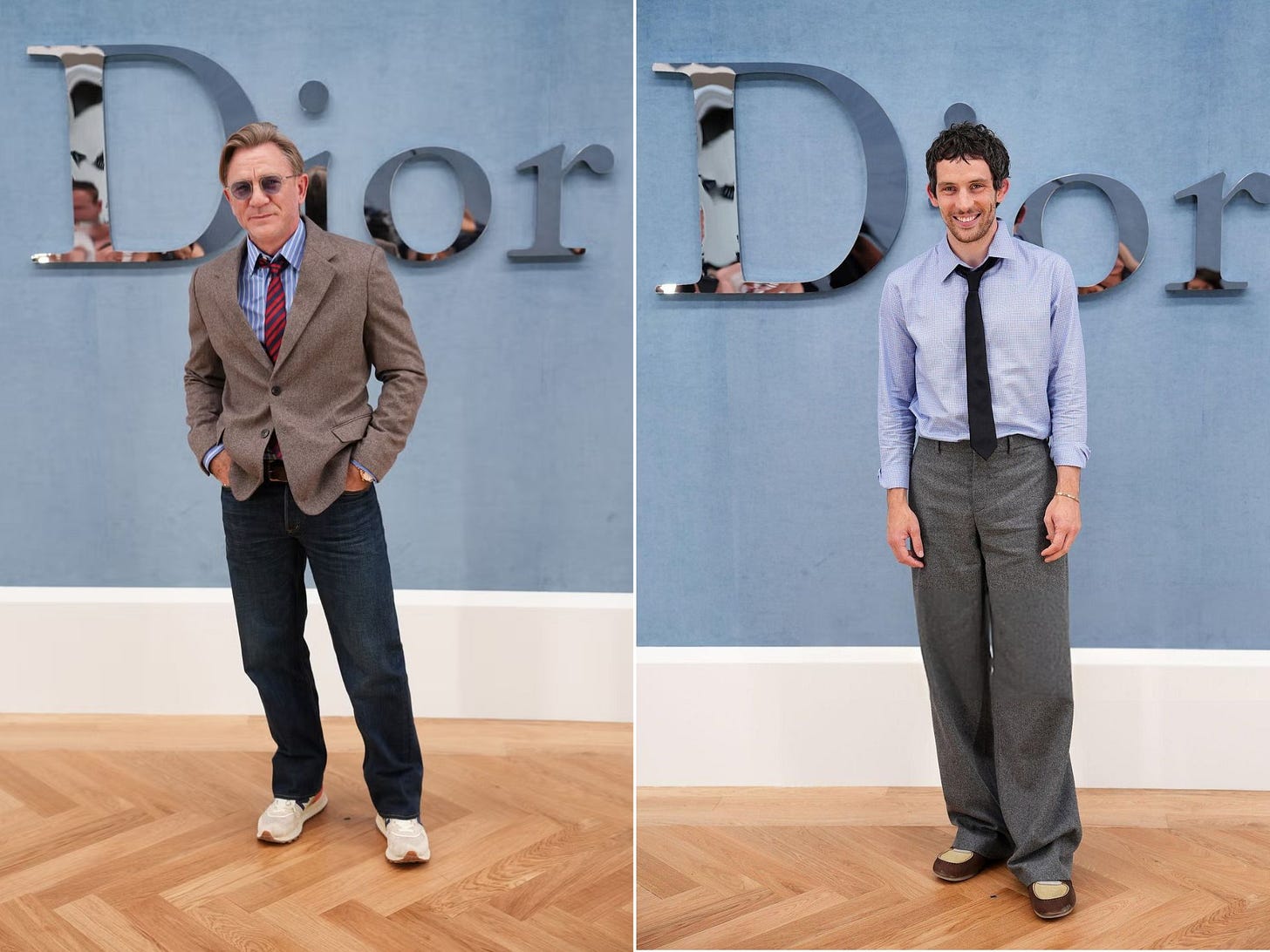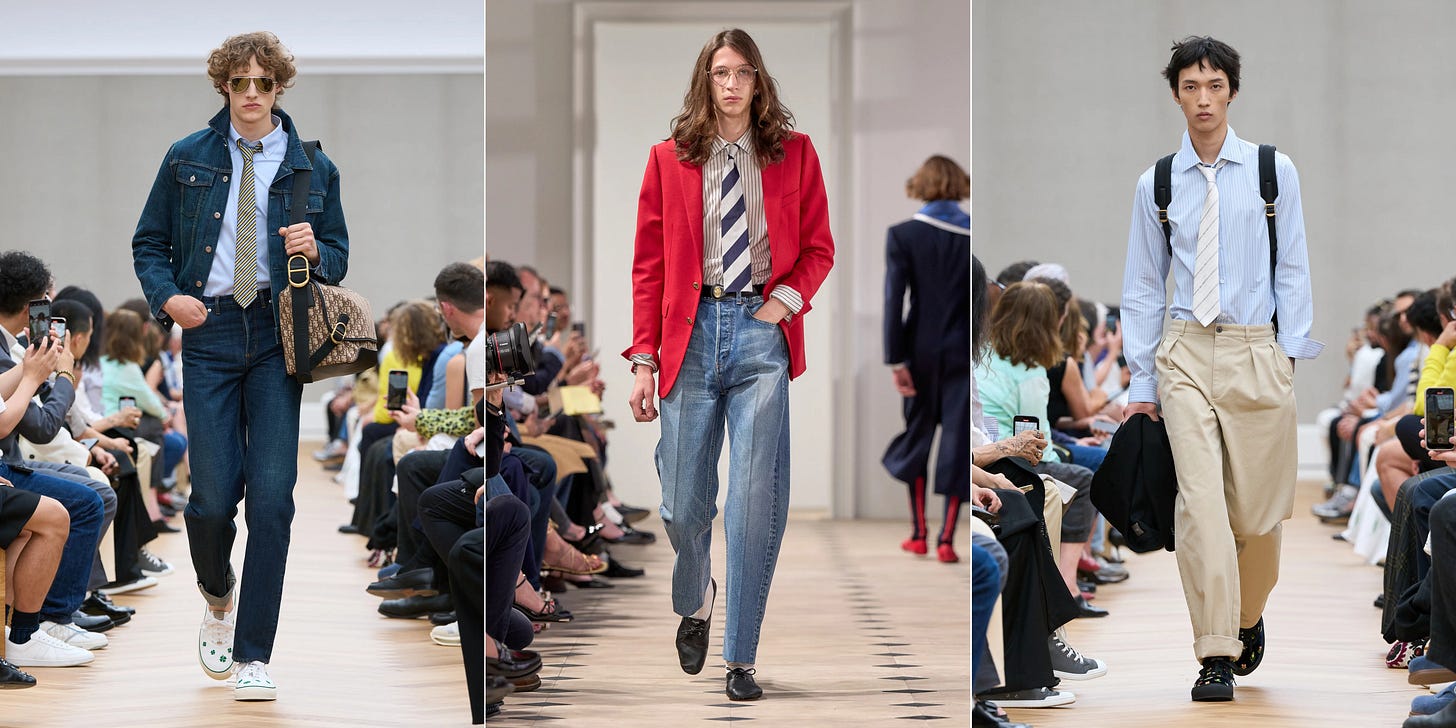The New Normal: Luxury Enters Its J. Crew Era
Notes on nostalgia, prep, Obama-era #Hope aesthetics, and sincerity.
J.Crew, of all things, has come up twice in as many weeks in conversations about the recent shows in Europe.
The first time was in reference to Josh O’Connor and Daniel Craig, both of whom attended Jonathan Anderson’s debut for Dior wearing outfits that evoked the mass retailer’s halcyon days—roughly from the late aughts to mid-2010s. O’Connor sported a pale blue micro-check Oxford shirt, messily tucked into a rather shapeless pair of gray wool pants (a four-figure Giant-Fit Chino dupe?) and a skinny tie. It might as well have been a J.Crew e-commerce shot from 2012.
Craig, meanwhile, wore dark denim that recalled Japanese selvage (a fabric I haven’t thought about in years), a striped collared shirt with a slightly undone rep tie, and dad sneakers—a callback to how former J.Crew head of men’s design, Frank Muytjens, used to dress. I remember when I first saw Muytjens pair a chambray shirt with a natty wool blazer—it blew my mind. I was hardly alone; it was a look emulated by so many creative types back then, in that period right before streetwear took over.
Between its rippling oversized cargo shorts (based on a 1948 dress design) and military-style jackets with bullion embroidery, the Dior show was chock full of rather ordinary garments: neckties, button-ups, jeans, and the occasional cable-knit sweater draped around the shoulders. Classic, traditional stuff. Outfits you’d see on men featured by The Sartorialist during his heyday. Heck, things you’d see on the street today.
A little more than a week later, Michael Rider showed his compelling—if overly styled—first outing at Celine. Afterward, Sean Santiago of Elle Decor shared an Instagram post from the brand and said it reminded him of the Jenna Lyons-J.Crew era. And, well, he’s not wrong. The navy blazer, the oversized crisp white shirt, denim that’s faded just so, and fistfuls of rings all feel very Lyons-coded: the mix of dressy and casual, the wayward prep energy, the ho-hum normality of it—but rendered just slightly askew. Most of all, the bourgeois attitude of it all.
Other hot brands have picked up on this too—most notably The Row and the ascendant Auralee. And anyone who knows me knows I believe all good things right now flow forth from the fountain of Miu Miu. Look at that brand’s last two spring collections: Spring 2025 closed with this look on Willem Dafoe—normal bordering on boring—while its pitch-perfect Spring 2024 collection was heavy on check shirts, preppy polos, and Harrington-style blouson jackets.
Right this very moment, the brand is selling this J.Crew-ass shirt and striped rugby polo on its website—both of which have their foot on my neck. Lord, if you grant me one wish, please let it be that one day I make that Miu Miu money.
All of this reminded me of my conversation last week with trend forecaster Michael Fisher—about flip-flops, of all things—and how he saw them aligning with two big cultural movements: the “Age of Average” and “Boredcore.” It’s telling that two big designer debuts channeled this feeling. In lieu of gauntlet-throwing, capital-D designed pieces, Anderson and Rider instead presented nondescript classics that possess a certain familiarity and bonhomie. Anderson, in particular, is known for his arty, crafty, borderline avant-garde streak, so to see him retreat to the conventional is, to me, especially notable.
“When I look at both of those collections, obviously they're preppy,” says Lawrence Schlossman of the podcast and Throwing Fits. Schlossman, of course, helped codify that original J.Crew look into popular culture as one of the instrumental voices of the #menswear movement, from his perch overseeing the fashion blog Four Pins. “I’m not shocked that preppy clothing, aesthetics, and styling tricks are being used to relaunch two huge brands. It’s a logical extension of what brands like The Row and Auralee are doing—these ‘advanced basic’ menswear things.”
“It’s just funny to see preppy being used as a vessel for commerce,” he continued. “To give this customer something just a little more exciting, just—seemingly—a little bit different. And then the styling was the cherry on top.” In a way, these designers are just taking the prep affectations already in the zeitgeist—boat shoes, rugby stripes, pops of color—and bringing them together. “This stuff is in the ether,” he said. “To see it congeal in both Dior and Celine in their own distinct ways was interesting.”
Look, you don’t need me to tell you that we are living in profoundly un-normal times. Political, financial, cultural, societal, environmental chaos is everywhere—it’s all coming undone, and quick. So to cosplay the aesthetics of the moment right before it all went haywire… why, yes, I do understand that sentiment.
After all, these looks harken back to the J.Crew of a very distinct period: from the post-2008 recession to the beginning of the Trump presidency in 2017. That was, in short, the Obama era—one that was hopeful and sincere (quite literally hashtag-hope). We thought a Black president meant we were in some post-racial future, and we still held the belief that social media was going to solve society’s ills while maintaining its hierarchical order.
It wouldn’t be until later that the tectonic plates would shift for fashion: Demna would introduce sweeping cynicism and arch irony into the industry in 2015 when he took over as creative director at Balenciaga. Streetwear, once an industry outlier, would fully integrate into the system in 2017 when Kim Jones, then at Louis Vuitton, invited Supreme to collaborate. For what it’s worth, that’s also the year Lyons left J.Crew.
I don’t think there’s any big revelation as to why we’re longing for the comforts of this particular pre-Trumpian time—the moment before the Internet warped our brains, when the wheels of society started to come off. It’s comforting there. There’s a purity to it, a sweetness. I’m not ashamed to admit I long for it.
Sean Monahan, the trend forecaster responsible for Normcore, the Vibe Shift, and, most recently, the “Boom Boom Aesthetic,” sees this as part of what he’s calling “Americana Overload.” He sees this expressing itself in a few ways: in the trashy, trucker hat–camouflage–ripped jeans aesthetic of Dimes Square; in the enduring “elevated workwear” look; and, more recently, in the way young men are embracing suits. “It’s a neo-yuppie, Patrick Bateman thing that’s very coastal,” he said. There’s something transgressive, even subversive, about wearing a suit in 2025, he says, especially in a way that references the 1980s, the time when money was unabashedly worshipped. It is, after all, the era when Donald Trump was forged.
“But then there's also the preppy Northeastern thing, which seems very much what Jonathan Anderson is interested in,” Monahan continued. “These are based on older ideas of luxury, and I think we're living in this moment of deep insecurity because it's unclear who the American elites are anymore. So young people or urban professionals are worrying about their own status, and going back to these conservative classics is a way to project status when they’re insecure about whether they actually have it.”
Maggie Bullock, author of The Kingdom of Prep: The Inside Rise and (Near) Fall of J.Crew and writer of the newsletter The Spread, sees a certain strain of conservatism in these clothes. “When Prep re-emerges, my instinctive fear response is: Is it our clothes or their clothes?” she said. She said these runway images brought to mind the sea of suits that accompanied New York Magazine’s story about the young MAGAites who brought Trump back to the White House. “That look on Daniel Craig… on another guy, it would just read as conservative.” For his part, Monahan also sensed a whiff of neoliberal ideology baked into these clothes.
However, what struck Bullock most about the Dior and Celine shows wasn’t the pieces themselves—but how they were presented, a J.Crew touchstone. “The secret recipe of J.Crew was always that these were fairly basic, boring clothes that were styled and put together in a way that made them greater than the sum of their parts,” she said. “It gave them a real tone.”
And while I’d love to pontificate on What These Clothes Mean™ all day, another, more straightforward force is likely at play: money. Luxury conglomerates like LVMH, which owns both Dior and Celine, are facing headwinds from a sluggish economy and an increasingly skeptical consumer. So these straightforward pieces can be seen as a rejoinder of sorts—some bait to lure them back.
“This reads to me as them trying to make clothes,” Bullock said, “and not just accessories. “Things that actually fit into our day-to-day lives. And these are the types of things we reach for time and again—blazers, jeans, button-ups. Maybe this is their attempt to meet consumers where they’re at.”
It’s still early, and things will come into sharper focus as the designer debuts roll out over the fall. Bottega Veneta, Versace, Loewe, Balenciaga, Gucci, Chanel, and Jil Sander will all present first-time collections from new creative directors. Who knows what they’ll be seeing in their crystal balls. In the meantime, let these J.Crew-style clothes soothe you as news about tariffs, global wars, fascism, and global warming clogs your feeds.
“I don't think these bring about feelings or emotions of despair or sadness or anxiety,” Schlossman said of the Celine and Dior collections. “It’s a fucking pink rep stripe tie—no one sees that and is depressed. You might think it’s whack and you wouldn’t wear it, but I think the majority of the feelings are of the warmer variety,” he said. “I just see this stuff and I’m like, it’s easy, it’s fun, it’s happy, it’s carefree.”










Does that mean my unimaginative wardrobe full of slightly preppy clothing items is trendy (again)?
Just watched the new Superman and Clark Kent is the only one in the office wearing a suit! Everyone else is still in business casual circa 2018.